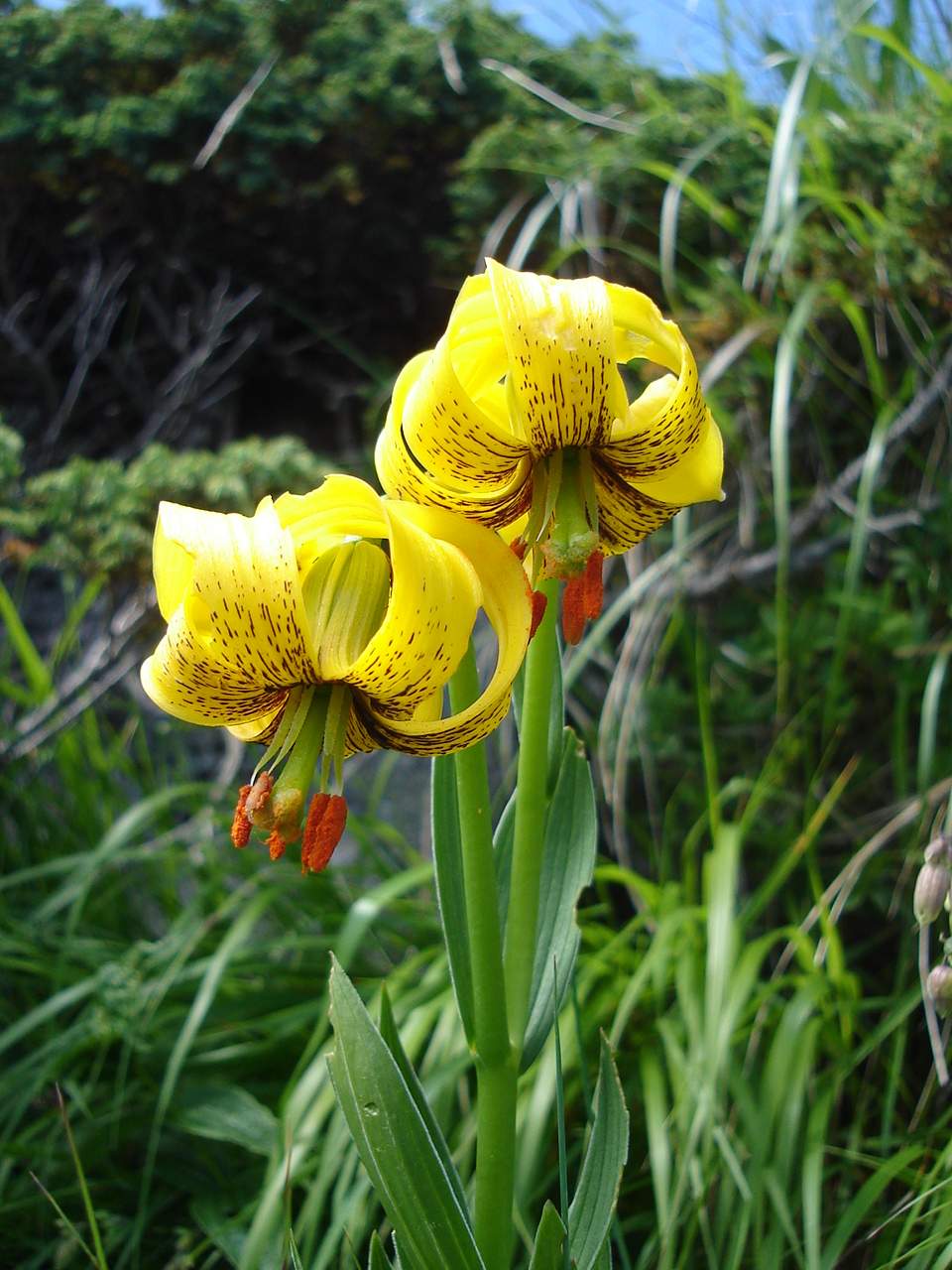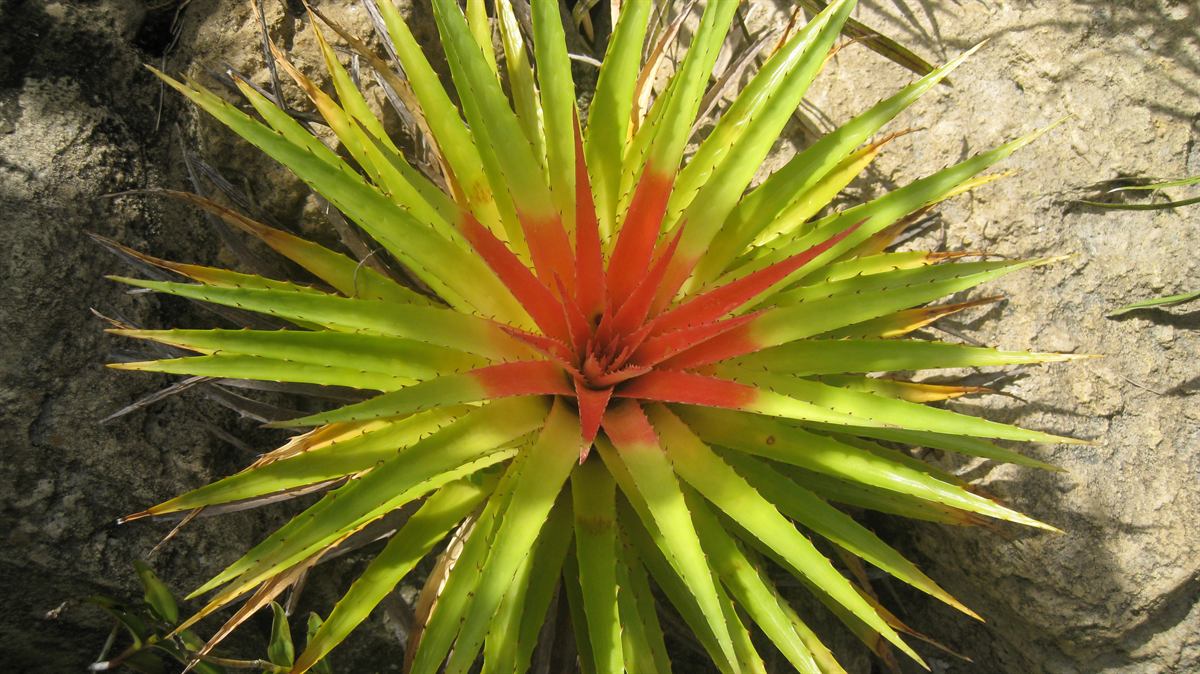|
Commelinidae
In plant taxonomy, commelinids (originally commelinoids) (plural, not capitalised) is a clade of flowering plants within the monocots, distinguished by having cell walls containing ferulic acid. The commelinids are the only clade that the APG IV system has informally named within the monocots. The remaining monocots are a paraphyletic unit. Also known as the commelinid monocots it forms one of three groupings within the monocots, and the final branch; the other two groups are the alismatid monocots and the lilioid monocots. Description Members of the commelinid clade have cell walls containing UV-fluorescent ferulic acid. Taxonomy The commelinids were first recognized as a formal group in 1967 by Armen Takhtajan Armen Leonovich Takhtajan or Takhtajian ( hy, Արմեն Լևոնի Թախտաջյան; russian: Армен Леонович Тахтаджян; surname also transliterated Takhtadjan, Takhtadzhi︠a︡n or Takhtadzhian, pronounced takh-tuh-JA ..., who named them ... [...More Info...] [...Related Items...] OR: [Wikipedia] [Google] [Baidu] |
Liliopsida
Liliopsida Batsch (synonym: Liliatae) is a botanical name for the class containing the family Liliaceae (or Lily Family). It is considered synonymous (or nearly synonymous) with the name monocotyledon. Publication of the name is credited to Scopoli (in 1760): see author citation (botany). This name is formed by replacing the termination ''-aceae'' in the name Liliaceae by the termination ''-opsida'' (Art 16 of the ICBN). Although in principle it is true that circumscription of this class will vary with the taxonomic system being used, in practice this name is very strongly linked to the Cronquist system, and the allied Takhtajan system. These two are the only major systems to use the name, and in both these systems it refers to the group more widely known as the monocotyledons. Earlier systems referred to this group by the name Monocotyledones, with Monocotyledoneae an earlier spelling (these names may be used in any rank). Systems such as the Dahlgren and Thorne systems (more ... [...More Info...] [...Related Items...] OR: [Wikipedia] [Google] [Baidu] |
Takhtajan System
A system of plant taxonomy, the Takhtajan system of plant classification was published by Armen Takhtajan, in several versions from the 1950s onwards. It is usually compared to the Cronquist system. It admits paraphyletic groups. Systems The first classification was published in Russian in 1954,and came to the attention of the rest of the world after publication of an English translation in 1958 as ''Origin of Angiospermous Plants''. Further versions appeared in 1959 (''Die Evolution der Angiospermen'') and 1966 (''Sistema i filogeniia tsvetkovykh rastenii''). The latter popularised Takhtajan's system when it appeared in English in 1969 (Flowering plants: Origin and dispersal). A further revision appeared in 1980. 1966 system * Magnoliophyta ( Angiospermae) p. 51 ** Class: Magnoliatae (Dicotyledones) p. 51 ** Class: Liliatae (Monocotyledones) p. 461 *** Subclass A: Alismidae p. 461 *** Subclass B: Liliidae p. 473 (was ''nom. nov.'') **** Supero ... [...More Info...] [...Related Items...] OR: [Wikipedia] [Google] [Baidu] |
Cronquist System
The Cronquist system is a taxonomic classification system of flowering plants. It was developed by Arthur Cronquist in a series of monographs and texts, including ''The Evolution and Classification of Flowering Plants'' (1968; 2nd edition, 1988) and ''An Integrated System of Classification of Flowering Plants'' (1981) (''see'' Bibliography). Cronquist's system places flowering plants into two broad classes, Magnoliopsida ( dicotyledons) and Liliopsida (monocotyledons). Within these classes, related orders are grouped into subclasses. While the scheme was widely used, in either the original form or in adapted versions, many botanists now use the Angiosperm Phylogeny Group classification for the orders and families of flowering plants, first developed in 1998. The system as laid out in Cronquist's ''An Integrated System of Classification of Flowering Plants'' (1981) counts 64 orders and 321 families in class Magnoliopsida and 19 orders and 65 families in class Liliopsida. ''The Evo ... [...More Info...] [...Related Items...] OR: [Wikipedia] [Google] [Baidu] |
Poales
The Poales are a large order of flowering plants in the monocotyledons, and includes families of plants such as the grasses, bromeliads, and sedges. Sixteen plant families are currently recognized by botanists to be part of Poales. Description The flowers are typically small, enclosed by bracts, and arranged in inflorescences (except in three species of the genus ''Mayaca'', which possess very reduced, one-flowered inflorescences). The flowers of many species are wind pollinated; the seeds usually contain starch. Taxonomy The APG III system (2009) accepts the order within a monocot clade called commelinids, and accepts the following 16 families: The earlier APG system (1998) adopted the same placement of the order, although it used the spelling "commelinoids". It did not include the Bromeliaceae and Mayaceae, but had the additional families Prioniaceae (now included in Thurniaceae), Sparganiaceae (now in Typhaceae), and Hydatellaceae (now transferred out of the monocots; ... [...More Info...] [...Related Items...] OR: [Wikipedia] [Google] [Baidu] |
Haemodorales
Commelinales is an order of flowering plants. It comprises five families: Commelinaceae, Haemodoraceae, Hanguanaceae, Philydraceae, and Pontederiaceae. All the families combined contain over 885 species in about 70 genera; the majority of species are in the Commelinaceae. Plants in the order share a number of synapomorphies that tie them together, such as a lack of mycorrhizal associations and tapetal raphides. Estimates differ as to when the Commelinales evolved, but most suggest an origin and diversification sometime during the mid- to late Cretaceous. Depending on the methods used, studies suggest a range of origin between 123 and 73 million years, with diversification occurring within the group 110 to 66 million years ago. The order's closest relatives are in the Zingiberales, which includes ginger, bananas, cardamom, and others.Stevens, P. F. (2001 onwards). Angiosperm Phylogeny Website. Version 9, November 2011. Taxonomy According to the most recent classification ... [...More Info...] [...Related Items...] OR: [Wikipedia] [Google] [Baidu] |
Monocotyledon
Monocotyledons (), commonly referred to as monocots, (Lilianae ''sensu'' Chase & Reveal) are grass and grass-like flowering plants (angiosperms), the seeds of which typically contain only one embryonic leaf, or cotyledon. They constitute one of the major groups into which the flowering plants have traditionally been divided; the rest of the flowering plants have two cotyledons and are classified as dicotyledons, or dicots. Monocotyledons have almost always been recognized as a group, but with various taxonomic ranks and under several different names. The APG III system of 2009 recognises a clade called "monocots" but does not assign it to a taxonomic rank. The monocotyledons include about 60,000 species, about a quarter of all angiosperms. The largest family in this group (and in the flowering plants as a whole) by number of species are the orchids (family Orchidaceae), with more than 20,000 species. About half as many species belong to the true grasses ( Poaceae), which are ... [...More Info...] [...Related Items...] OR: [Wikipedia] [Google] [Baidu] |
Commelinanae
Commelinales is an order of flowering plants. It comprises five families: Commelinaceae, Haemodoraceae, Hanguanaceae, Philydraceae, and Pontederiaceae. All the families combined contain over 885 species in about 70 genera; the majority of species are in the Commelinaceae. Plants in the order share a number of synapomorphies that tie them together, such as a lack of mycorrhizal associations and tapetal raphides. Estimates differ as to when the Commelinales evolved, but most suggest an origin and diversification sometime during the mid- to late Cretaceous. Depending on the methods used, studies suggest a range of origin between 123 and 73 million years, with diversification occurring within the group 110 to 66 million years ago. The order's closest relatives are in the Zingiberales, which includes ginger, bananas, cardamom, and others.Stevens, P. F. (2001 onwards). Angiosperm Phylogeny Website. Version 9, November 2011. Taxonomy According to the most recent classification ... [...More Info...] [...Related Items...] OR: [Wikipedia] [Google] [Baidu] |
Commelinales
Commelinales is an order of flowering plants. It comprises five families: Commelinaceae, Haemodoraceae, Hanguanaceae, Philydraceae, and Pontederiaceae. All the families combined contain over 885 species in about 70 genera; the majority of species are in the Commelinaceae. Plants in the order share a number of synapomorphies that tie them together, such as a lack of mycorrhizal associations and tapetal raphides. Estimates differ as to when the Commelinales evolved, but most suggest an origin and diversification sometime during the mid- to late Cretaceous. Depending on the methods used, studies suggest a range of origin between 123 and 73 million years, with diversification occurring within the group 110 to 66 million years ago. The order's closest relatives are in the Zingiberales, which includes ginger, bananas, cardamom, and others.Stevens, P. F. (2001 onwards). Angiosperm Phylogeny Website. Version 9, November 2011. Taxonomy According to the most recent classification scheme ... [...More Info...] [...Related Items...] OR: [Wikipedia] [Google] [Baidu] |
Monocots
Monocotyledons (), commonly referred to as monocots, (Lilianae ''sensu'' Chase & Reveal) are grass and grass-like flowering plants (angiosperms), the seeds of which typically contain only one embryonic leaf, or cotyledon. They constitute one of the major groups into which the flowering plants have traditionally been divided; the rest of the flowering plants have two cotyledons and are classified as dicotyledons, or dicots. Monocotyledons have almost always been recognized as a group, but with various taxonomic ranks and under several different names. The APG III system of 2009 recognises a clade called "monocots" but does not assign it to a taxonomic rank. The monocotyledons include about 60,000 species, about a quarter of all angiosperms. The largest family in this group (and in the flowering plants as a whole) by number of species are the orchids (family Orchidaceae), with more than 20,000 species. About half as many species belong to the true grasses (Poaceae), which are ec ... [...More Info...] [...Related Items...] OR: [Wikipedia] [Google] [Baidu] |
Bromelianae
Bromeliales is an order of flowering plants. Such an order has been recognized by a few systems of plant taxonomy, with a various placement. It appears that it always has had the same circumscription: consisting only of the family Bromeliaceae, the bromeliad or pineapple family. The order is not recognized in the APG II system, of 2003, which places the plants involved in the order Poales. Some examples are: * The Cronquist system of 1981 placed this order in subclass Zingiberidae, of class Liliopsida monocotyledons * The Thorne system (1992) placed the order in superorder Commelinanae in subclass Liliidae monocotyledons * The Dahlgren system placed the order in superorder Bromeliiflorae (also known as Bromelianae) in subclass Liliidae monocotyledonstogether with five other orders. * The Engler system, in its update of 1964, placed the order in class Monocotyledoneae Monocotyledons (), commonly referred to as monocots, (Lilianae ''sensu'' Chase & Reveal) are grass and gr ... [...More Info...] [...Related Items...] OR: [Wikipedia] [Google] [Baidu] |
Cannales
The Zingiberales are flowering plants forming one of four orders in the commelinids clade of monocots, together with its sister order, Commelinales. The order includes 68 genera and 2,600 species. Zingiberales are a unique though morphologically diverse order that has been widely recognised as such over a long period of time. They are usually large herbaceous plants with rhizomatous root systems and lacking an aerial stem except when flowering. Flowers are usually large and showy, and the stamens are often modified (staminodes) to also form colourful petal-like structures that attract pollinators. Zingiberales contain eight families that are informally considered as two groups, differing in the number of fertile stamens. A " banana group" of four families appeared first and were named on the basis of large banana-like leaves. Later, a more genetically coherent (monophyletic) "ginger group" appeared, consisting of the remaining four families. The order, which has a fossil record ... [...More Info...] [...Related Items...] OR: [Wikipedia] [Google] [Baidu] |



